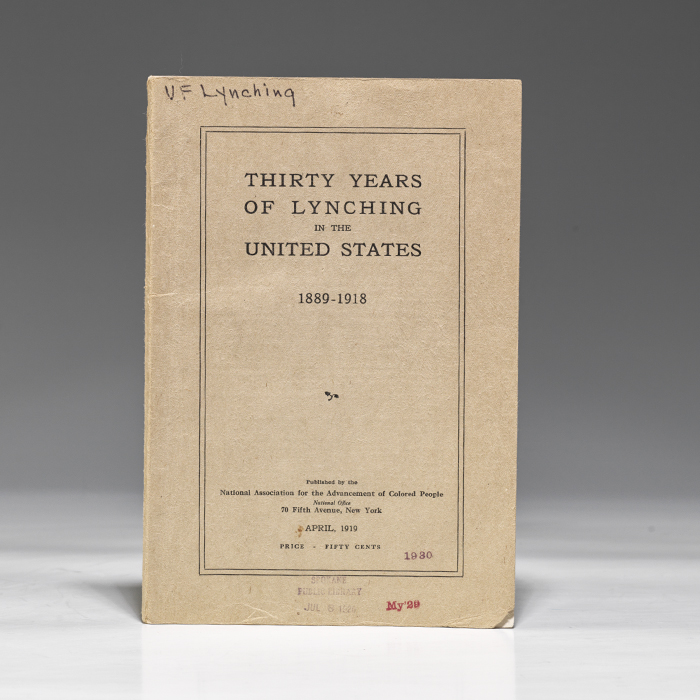
"MORE THAN 100 YEARS AND 200 FAILED ATTEMPTS": FIRST EDITION OF THE NAACP'S THIRTY YEARS OF LYNCHING IN THE UNITED STATES, 1889-1918
(SHILLADY, John.) (JOHNSON, James Weldon). Thirty Years of Lynching in the United States 1889-1918. New York: National Association for the Advancement of Colored People, 1919. Octavo, staple-bound as issued, original tan self-wrappers; pp.105. $2400.
First edition of a crucial 1919 work by the NAACP documenting the number, degree and savagery of American lynchings in "the circle of horror drawn around Black men, women and children," an exceptional copy in original self-wrappers.
To esteemed Black historian Cedric Robinson "the most dramatic and terrifying instrument in the repression of Blacks was lynching. According to the Department of Records and Research at Tuskegee Institute, between 1882 and 1968 there were 4,743 cases of death by lynching in America, with the period between 1892 and 1902 recording the most intensive activity… no federal agency amassed as complete a record as that at Tuskegee, so there is no 'official' count" (Black Movements, 105). In 1919 the NAACP took a major early step toward documenting the level and savagery of lynchings when it "sent two researchers into the Library of Congress to gather data… which appeared as Thirty Years of Lynching," a work that denounces the U.S. as "the only advanced nation whose government has tolerated lynching" (Tyndall, Emergence of the New South, 173). Here the NAACP speaks to a widely held conviction (before and since 1919) "that the actual number of lynchings was considerably higher" than any existing count. Thirty Years of Lynching, for example, offers a potentially higher figure by maintaining "that between 1889 and 1918 the number of lynching victims already amounted to 3,224—2,522 of them Black. Moreover, lynching as defined narrowly… did not include the varied forms of terrorism (rape, beating, torture, mutilation, arson threats) that completed the circle of horror drawn around Black men, women and children" (Black Movements, 105).
The NAACP was "focused on changing public opinion… [in] a society that was at best ambivalent over the lynching of African Americans" (Francis, Rethinking Civil Rights, 54). At the time it was headed by John Shillady, a white former social worker, with Walter White as assistant secretary and James Weldon Johnson as field secretary. In 1919, the same year this work was issued, Texas vowed to shut down its NAACP branches and Shillady traveled there to see the governor, who refused to meet him. Instead Shillady was badly beaten by a group that included a judge and constable. On returning to New York, physically and mentally broken, he soon resigned. But to Johnson and White, both "Black activists reared in the Jim Crow South," the attack only "fired their own resolve to get a federal law enacted," and in 1920 Johnson became executive secretary of the NAACP (Zangrando, NAACP Crusade, 52). However, it was not until early 2022 that the first federal law was enacted in the Emmett Till Anti-Lynching Act, a milestone on a path that "took more than 100 years and 200 failed attempts" (NPR). First edition, first printing: with errata slip between pages 26-27, containing four full-page maps and charts. Front wrapper with inked "V. F. Lynching," small inkstamps with very faint 1920 library stamp.
Text fresh with scant edge-wear to front wrapper. A very scarce about-fine copy.